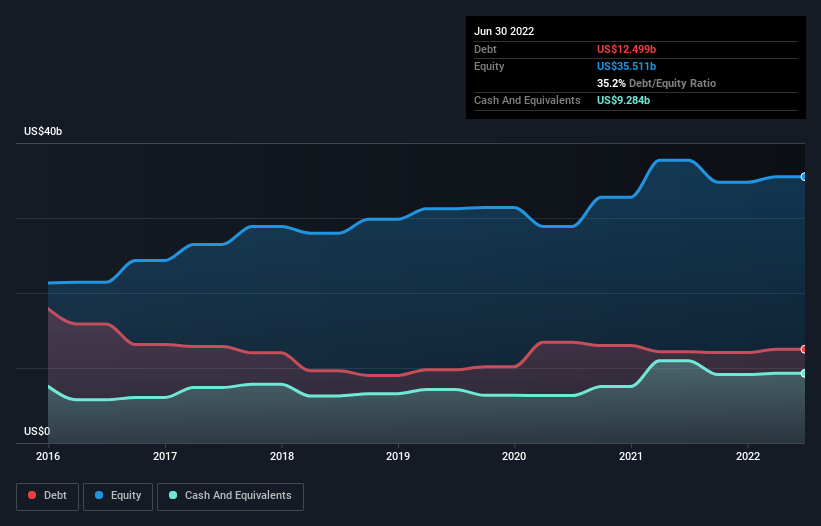
Warren Buffett famously said, 'Volatility is far from synonymous with risk.' So it seems the smart money knows that debt - which is usually involved in bankruptcies - is a very important factor, when you assess how risky a company is. As with many other companies Anglo American plc (LON:AAL) makes use of debt. But the real question is whether this debt is making the company risky.
Why Does Debt Bring Risk?
Debt assists a business until the business has trouble paying it off, either with new capital or with free cash flow. Part and parcel of capitalism is the process of 'creative destruction' where failed businesses are mercilessly liquidated by their bankers. However, a more common (but still painful) scenario is that it has to raise new equity capital at a low price, thus permanently diluting shareholders. Having said that, the most common situation is where a company manages its debt reasonably well - and to its own advantage. When we examine debt levels, we first consider both cash and debt levels, together.
Our analysis indicates that AAL is potentially undervalued!
What Is Anglo American's Debt?
The chart below, which you can click on for greater detail, shows that Anglo American had US$12.5b in debt in June 2022; about the same as the year before. On the flip side, it has US$9.28b in cash leading to net debt of about US$3.22b.

How Healthy Is Anglo American's Balance Sheet?
Zooming in on the latest balance sheet data, we can see that Anglo American had liabilities of US$10.3b due within 12 months and liabilities of US$20.9b due beyond that. On the other hand, it had cash of US$9.28b and US$3.82b worth of receivables due within a year. So its liabilities outweigh the sum of its cash and (near-term) receivables by US$18.0b.
While this might seem like a lot, it is not so bad since Anglo American has a huge market capitalization of US$47.8b, and so it could probably strengthen its balance sheet by raising capital if it needed to. But it's clear that we should definitely closely examine whether it can manage its debt without dilution.
In order to size up a company's debt relative to its earnings, we calculate its net debt divided by its earnings before interest, tax, depreciation, and amortization (EBITDA) and its earnings before interest and tax (EBIT) divided by its interest expense (its interest cover). Thus we consider debt relative to earnings both with and without depreciation and amortization expenses.
Anglo American's net debt is only 0.20 times its EBITDA. And its EBIT easily covers its interest expense, being 56.4 times the size. So you could argue it is no more threatened by its debt than an elephant is by a mouse. But the bad news is that Anglo American has seen its EBIT plunge 11% in the last twelve months. If that rate of decline in earnings continues, the company could find itself in a tight spot. The balance sheet is clearly the area to focus on when you are analysing debt. But it is future earnings, more than anything, that will determine Anglo American's ability to maintain a healthy balance sheet going forward. So if you want to see what the professionals think, you might find this free report on analyst profit forecasts to be interesting.
Finally, while the tax-man may adore accounting profits, lenders only accept cold hard cash. So it's worth checking how much of that EBIT is backed by free cash flow. During the last three years, Anglo American produced sturdy free cash flow equating to 51% of its EBIT, about what we'd expect. This free cash flow puts the company in a good position to pay down debt, when appropriate.
Our View
Anglo American's interest cover was a real positive on this analysis, as was its net debt to EBITDA. Having said that, its EBIT growth rate somewhat sensitizes us to potential future risks to the balance sheet. Looking at all this data makes us feel a little cautious about Anglo American's debt levels. While debt does have its upside in higher potential returns, we think shareholders should definitely consider how debt levels might make the stock more risky. The balance sheet is clearly the area to focus on when you are analysing debt. However, not all investment risk resides within the balance sheet - far from it. For example, we've discovered 2 warning signs for Anglo American (1 is concerning!) that you should be aware of before investing here.
When all is said and done, sometimes its easier to focus on companies that don't even need debt. Readers can access a list of growth stocks with zero net debt 100% free, right now.
New: Manage All Your Stock Portfolios in One Place
We've created the ultimate portfolio companion for stock investors, and it's free.
• Connect an unlimited number of Portfolios and see your total in one currency
• Be alerted to new Warning Signs or Risks via email or mobile
• Track the Fair Value of your stocks
Have feedback on this article? Concerned about the content? Get in touch with us directly. Alternatively, email editorial-team (at) simplywallst.com.
This article by Simply Wall St is general in nature. We provide commentary based on historical data and analyst forecasts only using an unbiased methodology and our articles are not intended to be financial advice. It does not constitute a recommendation to buy or sell any stock, and does not take account of your objectives, or your financial situation. We aim to bring you long-term focused analysis driven by fundamental data. Note that our analysis may not factor in the latest price-sensitive company announcements or qualitative material. Simply Wall St has no position in any stocks mentioned.
About LSE:AAL
Anglo American
Operates as a mining company in the United Kingdom and internationally.
Adequate balance sheet and fair value.
Similar Companies
Market Insights
Community Narratives



